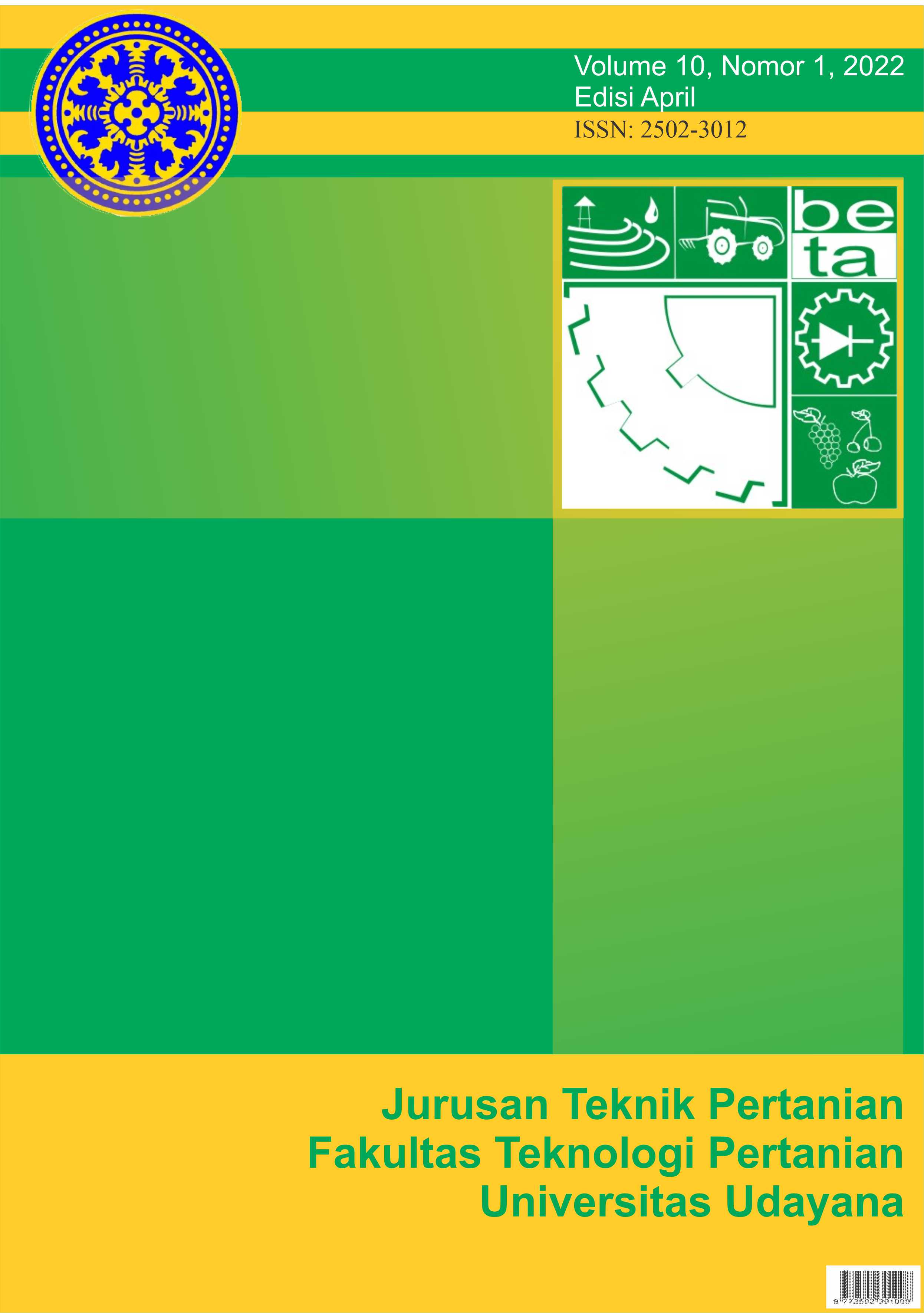Efektivitas Rorak untuk Konservasi Tanah pada Perkebunan Kopi
Abstract
Abstrak
Penelitian ini dilakukan untuk menganalisis perbedaan lahan dengan perlakuan rorak dan tanpa rorak terhadap sifat fisik dan kimia tanah. Analisis data secara deskriptif kuantitatif dengan mengolah data primer (sifat fisik dan kimia tanah) dan sekunder (data kajian studi literatur dan data iklim wilayah penelitian). Hasil penelitian menunjukkan bahwa ada perbedaan sifat fisik tanah pada tiap perlakuan, berat jenis tanah pada perlakuan tanpa rorak lebih tinggi yaitu 1,26 g/cm3 daripada perlakuan rorak 1,24 g/cm3, berat volume tanah pada perlakuan tanpa rorak lebih tinggi yaitu 0,89 g/cm3 daripada perlakuan rorak 0,55 g/cm3, porositas pada perlakuan rorak lebih tinggi yaitu 55,5 % dibandingkan tanpa rorak 29,5 % dan kadar lengas maksimum perlakuan rorak lebih tinggi yaitu 82,54 % dibandingkan tanpa rorak 68,35 %. Hasil penelitian terhadap sifat kimia tanah menunjukkan bahwa terdapat perbedaan sifat kimia pada tiap perlakuan. Sifat kimia tanah pada perlakuan rorak memiliki kadar Nitrogen, Phospor, Kalium dan C-organic lebih tinggi sebesar 0,50 % (Nitrogen), 7,33 ppm (Phosphor), 0,42 me/100 g (Kalium), 4,1 % (C-organik) dibandingkan pada perlakuan tanpa rorak sebesar 0,16 % (Nitrogen), 7,18 ppm (Phosphor), 0,24 me/100 g (Kalium), 2,3 % (C-Organik). Pembuatan rorak dengan ukuran panjang 1,50 m, lebar 1,00 m dalam 0,40 m kapasitas tampungnya yaitu 0,60 m3, air di dalam rorak akan habis dalam waktu rata-rata 1,96 jam dengan laju peresapan airnya rata-rata 0,32 m3/jam. Jumlah rorak/ha yang optimal sebanyak 336 buah karena memiliki volume air yang tersedia sebesar 201,60 m3/ha/hari. Jumlah tersebut mampu mencukupi kebutuhan air tanaman kopi yaitu 180 m3/ha/hari.
Abstract
This study was conducted to analyze land differences with Rorak treatment and without Rorak on the physical and chemical properties of the soil. The analysis used is quantitative descriptive by processing primary data (physical and chemical properties of soil) and secondary data (data from the study of literature and climate data in the research area). The results showed differences in the physical properties of the soil in each treatment. The specific soil gravity without a Rorak was higher (1,26 g/cm3) than the Rorak treatment (1.24 g/cm3). The weight of the soil volume in the treatment without rorak was higher (0.89 g/cm3) than in the Rorak treatment (0.55 g/cm3). The porosity in the rorak treatment was higher (55.5%) than without the Rorak (29.5%). The maximum moisture content of the Rorak treatment was 82.54% higher than without rorak 68,35%. The results showed the chemical properties of the soil showed that there were differences in the chemical properties of each treatment. Soil chemical properties in Rorak treatment had higher levels of Nitrogen (0.50%), Phosphorus (7.33 ppm), Potassium (0.42 me/100 g), and C-organic (4.1 %) than treatment without Rorak Nitrogen (0.16 %), Phosphor (7.18 ppm), Potassium (0.24 me/100 g), C-Organic (2.3%). Making a Rorak with a length of 1.50 m, a width of 1.00 m in 0.40 m, the capacity of which is 0.60 m3, the water in the rorak will run out in an average of 1.96 hours with an average water infiltration rate 0.32 m3/hour. The optimal amount of Rorak/ha is 336 because it has an available water volume of 201.60 m3/ha/day. This amount can meet the water needs of coffee plants, which is 180 m3/ha/day.
Downloads
References
Doorenbos J., and Pruitt W. O. 1977. Crop Water Requirements. FAO Irrigation and Drainage Paper 24. Rome, Italy.
Ginting, Rasmita. 2010. Laju Resapan Air Pada Berbagai Jenis Tanah Dan Berat Jerami Dengan Menerapkan Teknologi Biopori Di Kecamatan Medan Amplas. Sekolah Pascasarjana Universitas Sumatera Utara. Tesis tidak diterbitkan. Medan.
Husni, Mulia Rahmat., Sufardi, and Munawar Khalil. 2016. Evaluasi Status Kesuburan Pada Beberapa Jenis Tanah Di Lahan Kering Kabupaten Pidie Provinsi Aceh. Vol 1(1): Hal 147–54.
International Coffee Organization (ICO). 2017. Total Production by All Exporting Countries. Retrieved (http://www.ico.org/prices/po-production.pdf).
Pereira., Antonio Roberto., Marcelo Bento Paes de Camargo., and Nilson Augusto Villa Nova. 2011. Coffee Crop Coefficient for Precision Irrigation Based on Leaf Area Index. Vol 70(4): Hal 946–51. doi: 10.1590/s0006-87052011000400030.
Pratiwi., and Andi Gustiani Salim. 2013. Aplikasi Teknik Konservasi Tanah Dengan Sistem Rorak Pada Tanaman Gmelina (Gmelina Arborea Roxb.) Di KHDTK Carita, Banten. Vol 10(3): Hal 273–82.
Pudji, Rahardjo. 2012. Panduan Budidaya Dan Pengelolaan Kopi Robusta Dan Arabika. Cet 1. Jakarta: Penebar Swadaya.
Purwoto, Harsunu. 2013. Soil And Water Conservation Engineering. 1st ed. Yogyakarta: Instiper Yogyakarta.
Raharjo, Akhmadi Puguh. 2020. Simulasi Penempatan Rorak Sebagai Bentuk Pengoptimalan Konservasi Air. Vol. 4 No. 2 4(2): Hal 123–33.
Satibi., Muhammad Nasamsir., and Hayata. 2019. Pembuatan Rorak Pada Perkebunan Kopi Arabica (Coffea Arabica ) Untuk Meningkatkan Produktivitas. Vol 4(2): Hal 74. doi: 10.33087/jagro.v4i2.85.
Siregar, Budiman. 2017. Analisa Kadar C-Organik Dan Perbandingan C/N Tanah Di Lahan Tambak Kelurahan Sicanang Kecamatan Medan Belawan. Vol 53(1): Hal 1–14.












 Jurnal BETA (Biosistem dan Teknik Pertanian)
Jurnal BETA (Biosistem dan Teknik Pertanian)


